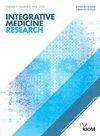Efficacy of herbal medicine Xiao-Feng-San combined with auricular acupuncture for atopic dermatitis: A randomized controlled trial
IF 3
4区 医学
Q2 INTEGRATIVE & COMPLEMENTARY MEDICINE
引用次数: 0
Abstract
Background
Atopic dermatitis (AD) is a common chronic inflammatory skin disease with a considerable burden. Xiao-Feng-San (XFS) has been widely used in traditional medicine for the wind-dampness-heat pattern. Auricular acupuncture (AA) may relieve AD symptoms, but its added benefit with XFS is unclear.
Methods
In this randomized, sham-controlled clinical trial, 156 adults with non-severe AD and wind-dampness-heat pattern, all of whom were prescribed XFS decoction, were additionally assigned to receive either AA (XFS plus AA group, n=78) or sham AA (XFS plus Sham AA group, n=78) for four weeks. The primary outcome was the change in the SCORAD index from baseline to week 4. Secondary outcomes included fexofenadine use, Dermatology Life Quality Index (DLQI), serum total IgE, and adverse events.
Results
Compared with the XFS plus sham AA, the XFS plus AA group showed a significantly greater reduction in SCORAD at week 4 (mean difference [MD] −9.1; p < 0.0001), exceeding the minimal clinically important difference. DLQI also improved more in the XFS plus AA group (MD −1.8; p = 0.0362). Fexofenadine use was lower in this group, though not significantly; no significant differences in serum total IgE were found. Adverse events were mild and transient.
Conclusions
Adding AA to XFS enhanced clinical outcomes and quality of life in patients with non-severe AD, with a favorable safety profile. These findings support AA as a promising adjunctive therapy in integrative approaches for AD. Further studies should validate these results across broader populations, with post-intervention follow-up, and diverse traditional medicine regimens.
Trial registration information
ClinicalTrials.gov (NCT06492902).
中药消风散联合耳针治疗特应性皮炎的疗效:随机对照试验
背景:过敏性皮炎(AD)是一种常见的慢性炎症性皮肤病,负担相当重。小风散在中医中被广泛应用于风湿热证。耳针(AA)可能缓解AD症状,但其与XFS的附加益处尚不清楚。方法在随机、假对照的临床试验中,156例非重度AD、风湿热型成人患者,均给予XFS汤剂治疗,在此基础上分为AA组(XFS加AA组,n=78)和假AA组(XFS加假AA组,n=78),疗程4周。主要终点是SCORAD指数从基线到第4周的变化。次要结局包括非索非那定使用情况、皮肤病生活质量指数(DLQI)、血清总IgE和不良事件。结果与XFS +假性AA组相比,XFS + AA组在第4周时SCORAD的降低显著更大(平均差异[MD] - 9.1; p < 0.0001),超过了最小的临床重要差异。XFS + AA组DLQI改善更明显(MD = 1.8; p = 0.0362)。该组非索非那定的使用较低,但不明显;血清总IgE无显著差异。不良事件轻微且短暂。结论在XFS中加入AA可改善非重度AD患者的临床结果和生活质量,并具有良好的安全性。这些发现支持AA作为一种有希望的AD综合治疗辅助疗法。进一步的研究应该在更广泛的人群中,通过干预后随访和不同的传统医学方案来验证这些结果。临床试验注册信息clinicaltrials .gov (NCT06492902)。
本文章由计算机程序翻译,如有差异,请以英文原文为准。
求助全文
约1分钟内获得全文
求助全文
来源期刊

Integrative Medicine Research
Medicine-Complementary and Alternative Medicine
CiteScore
6.50
自引率
2.90%
发文量
65
审稿时长
12 weeks
期刊介绍:
Integrative Medicine Research (IMR) is a quarterly, peer-reviewed journal focused on scientific research for integrative medicine including traditional medicine (emphasis on acupuncture and herbal medicine), complementary and alternative medicine, and systems medicine. The journal includes papers on basic research, clinical research, methodology, theory, computational analysis and modelling, topical reviews, medical history, education and policy based on physiology, pathology, diagnosis and the systems approach in the field of integrative medicine.
 求助内容:
求助内容: 应助结果提醒方式:
应助结果提醒方式:


